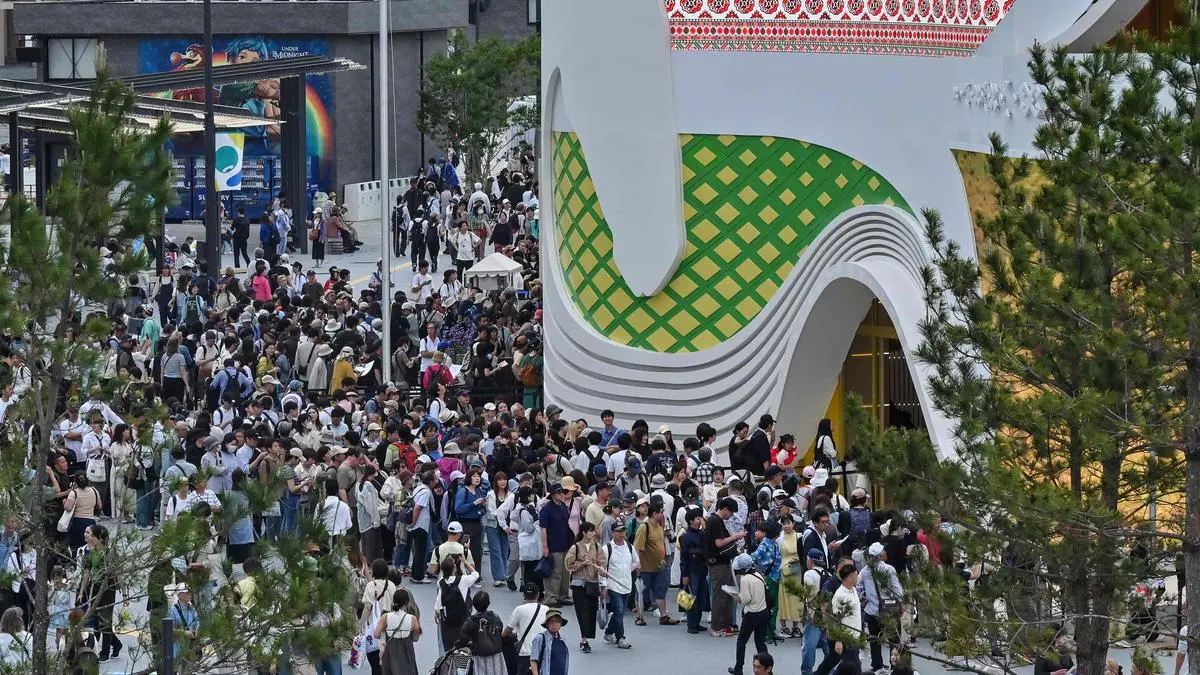The India Pavilion at the ongoing World Expo in Osaka is a celebration of the country’s rich heritage, and its design with sustainability at core draws inspiration from the image of Bodhisattva Padmapani in the ancient Ajanta Caves.
A top official of the Indira Gandhi National Centre for the Arts (IGNCA) here on Saturday said, the pavilion with its iconic facade with blue lotus motif, is currently among the “top five most-visited pavilions” at the mega fair in Japan.
Later, the IGNCA, in a statement, said that the other four countries in the top five list, whose pavilions are drawing huge crowd are — the US, Italy, Japan and France.
The India Pavilion stands as a testament to the nation’s ancient wisdom, modern ambitions and global partnerships, officials said.
Strategically placed in the ‘Connecting Lives’ zone at the World Expo 2025 in Osaka, the pavilion captures India’s civilisational depth while highlighting its technological advancement and commitment to sustainable development.
“It embodies the nation’s values of inclusivity, sustainability and progress, serving as a bridge between its spiritual heritage and its ambitious future,” according to a booklet on the pavilion shared by the IGNCA.
The IGNCA is an autonomous institution under the Ministry of Culture.
Sachchidanand Joshi, Member Secretary, IGNCA during an interaction with reporters said the the blue lotus with 24 petals, also carries the message of Lord Buddha while adhering to the idea of sustainability as they are made of a type of fibre that is biodegradable.
The imagery is drawn from a mural at the ancient Ajanta Caves in Maharashtra depicting the Bodhisattva Padmapani, holding a lotus in his right hand.
“The design of the pavilion is a tribute to Bodhisattva Padmapani (the Bodhisattva of Compassion) from the iconic Ajanta Caves, symbolising compassion, enlightenment and knowledge,” the booklet says.
Through a seamless blend of architecture, storytelling and immersive experiences, the pavilion creates a dynamic space for cultural exchange, reinforcing its role in fostering global connections, it adds.
The Pavilion comprises diverse sections dedicated to innovation, heritage, Ayurveda, ISRO, and sustainable development, offering a compelling narrative of India’s journey from its subterranean treasures to outer space.
While paying homage to the past, the Pavilion also envisions the possibilities of the future, IGNCA officials said The cost incurred on the construction of the pavilion was around Rs 225 crore, exclusive of ancillary operational costs, they said.
Joshi said a huge ‘Bodhi Tree’ installation is inside the pavilion, besides sections on Indian textile heritage, terracotta artworks and a brass gallery.
“The pavilion spans 1,751 sq m, the indoor display is in an ‘x-box’ category structure allotted by the expo authorities to which not even a nail can be added. So, we wrapped a simple looking box with a blue lotus artwork, thereby both enhancing its appeal and projecting India’s cultural heritage,” he said.
Besides, plaques made of soils brought from different states and UTs and mixed in India, depicting cultural elements of different states have also been showcased, to depict the spirit of ‘Ek Bharat Shreshth Bharat’, the member secretary said.
Other zones inside the pavilion include bilateral spaces for diplomatic engagements, the Bharat Bazaar, Indian food zone showcasing the country’s street food besides a corporate hub.
Sources said the huge petals of the blue lotus were manufactured in Bengaluru, and along with other artefacts and civil material were transported by air from Chennai to Japan via Hong Kong.
Since, some of the structures were very huge and had a massive weight, they had to be transported in parts in different flights, which were reassembled in Japan, they said, emphasising the challenges faced in putting together the pavilion.
This initiative is being spearheaded by the Ministry of Commerce, with the guidance of the Ministry of Culture, and is being realised with institutional collaboration from the India Trade Promotion Organisation (ITPO) and the IGNCA.
“The creative vision and intricate cultural design of the pavilion were executed by IGNCA in a remarkably short span of time, demonstrating not only institutional agility but deep-rooted cultural sensibility,” the IGNCA said.
The World Expo 2025, currently underway in the city of Osaka, began on April 13 and will continue till October 13.
Over 160 countries and 9 international organisations are participating in the exposition, which is expected to attract nearly 28 million visitors, the IGNCA said.
Published on June 7, 2025
